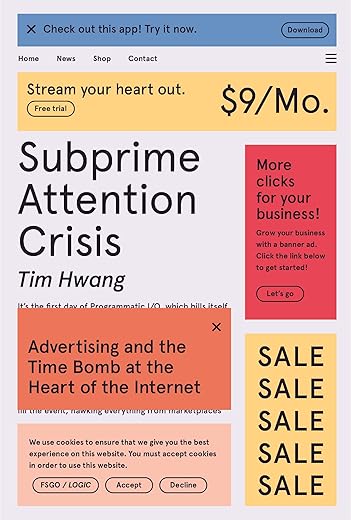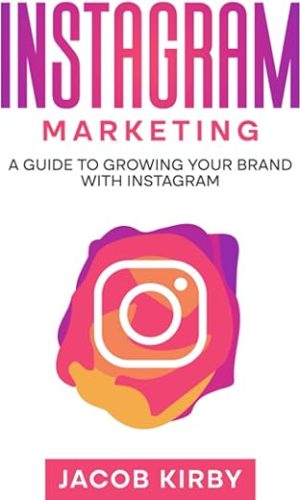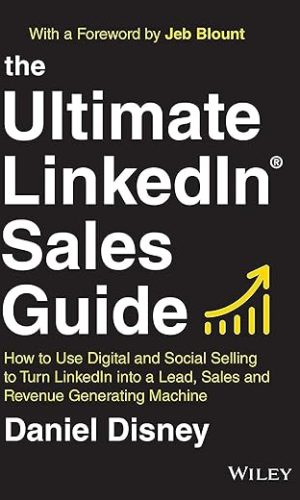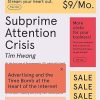Subprime Attention Crisis: Advertising and the Time Bomb at the Heart of the Internet (FSG Originals x Logic)
£10.40
In Subprime Attention Crisis, Tim Hwang investigates the way big tech financialises attention. In the process, he shows us how digital advertising – the beating heart of the internet – is at risk of collapsing, and that its potential demise bears an uncanny resemblance to the housing crisis of 2008. From the unreliability of advertising numbers and the unregulated automation of advertising bidding wars, to the simple fact that online ads mostly fail to work, Hwang demonstrates that while consumers’ attention has never been more prized, the true value of that attention itself – much like subprime mortgages – is wildly misrepresented. And if online advertising goes belly-up, the internet – and its free services – will suddenly be accessible only to those who can afford it. Deeply researched, convincing, and alarming, Subprime Attention Crisis will change the way you look at the internet, and its precarious future. FSG Originals × Logic dissects the way technology functions in everyday lives. The titans of Silicon Valley, for all their utopian imaginings, never really had our best interests at heart: recent threats to democracy, truth, privacy, and safety, as a result of tech’s reckless pursuit of progress, have shown as much. We present an alternate story, one that delights in capturing technology in all its contradictions and innovation, across borders and socioeconomic divisions, from history through the future, beyond platitudes and PR hype, and past doom and gloom. Our collaboration features four brief but provocative forays into the tech industry’s many worlds, and aspires to incite fresh conversations about technology focused on nuanced and accessible explorations of the emerging tools that reorganize and redefine life today
Read more
Additional information
| Publisher | FSG (13 Oct. 2020) |
|---|---|
| Language | English |
| Paperback | 176 pages |
| ISBN-10 | 0374538654 |
| ISBN-13 | 978-0374538651 |
| Dimensions | 12.7 x 1.14 x 19.05 cm |










by G.C.
Thoroughly enjoyable and fascinating review of the current state of online advertising and the potential dangers lurking in our enthusiasm for a model that is over controlled by a few players such as Google and Facebook, misunderstood by agencies and clients but underpins the whole internet economy.
Well worth reading.
by G.C.
Subprime attention crisis is a short book, or a long essay depending on the way you want to look at it. It was written by Tim Hwang.
About Tim Hwang
Hwang is a lawyer working for email newsletter platform Substack. Prior to this he worked in a US think tank attached to Georgetown University: Center for Security and Emerging Technology and in public policy at Google focused on machine learning. So he brings a deep set of knowledge to writing Subprime attention crisis. One also has to bear in mind that his current employee Substack is based on the online media model moving from online advertising driven to subscription driven.
Timing is everything
I read this book over a couple of days at the beginning of this month. By this time, Meta and Alphabet has published quarterly results that were below what investors expected with falling sales.
On the other hand, one could also argue that much of the crisis had already landed. Ad tech businesses like Rubicon Project have either gone under or merged with their peers creating a massive amount of consolidation. The latest wave of consolidation happened in 2020 – 2021.
Hwang in Subprime attention crisis points out many of the things that agency employees and owners have known for years:
Online advertising effectiveness has declined compared to its performance 25 years ago
Audiences don’t see a lot of the ads that are displayed. Different reports will give you different numbers on this
Online advertising is destroying the very media industry that its content is shown on
Online advertising fraud is a big problem
Online advertising business practices are an even bigger problem with up to 70 percent of of online programmatic advertising spend going to advertising technology intermediaries such as The Rubicon Project (now Magnite) and Xaxis
This has allowed businesses like Procter & Gamble and adidas to reduce advertising spend at no loss in effectiveness. In the case of P&G Subprime attention crisis highlights how they cut $200 million in online advertising spend, moved that spend on to offline media like radio and print AND managed to increase their reach by 10 percent.
One of the most notable things for me was being introduced to the work of Australian based academic Nico Neumann who has done some great research on online advertising effectiveness related areas including Frontiers: How Effective Is Third-Party Consumer Profiling? Evidence from Field Studies.
So nothing surprising for insiders, but….
Hwang marshals his facts well. Which is what you would expect from a lawyer. He uses analogous examples from the US financial services sector including the 2008 financial crisis. The book itself is 141 pages in length and there is a substantial section detailing his sources. Subprime attention crisis is based exclusively on desk research.
by Amazon Customer
This book reads like a blog post, a not particularly well researched one & likening digital advertising to subprime is a bridge too far. Your choice but I’d save your money.
by ~James~
I heard about this book from a recent feature on the Freakonomics podcast. It’s going to be a divisive subject as there’s a lot of people who’s careers are intrinsically bound up in online advertising (witness the only other review at the current time, the writer of which somewhat nullifies his comments by stooping to an angry ad hominem attack on the author).
The author makes a collection of fair comments (backed up with studies) about the online ad industry in support of his assertion that the value of reader attention is declining. Most ads are never seen, a majority of users are now ad blocking (at least on desktop). Only a small percentage of users account for most ad interaction. Most of those users are in an older demographic which is declining. There is a high percentage of click fraud and other frauds. The measurable returns on digital advertising for brands are possibly not really there. If those brands suddenly decide to take their money elsewhere it could have a significant impact on the whole web economy.
I found this book a good read and my only real critique is that it’s a little short.
by Jonathan Briggs
Meandering, confused, and overall a waste of time, ‘Subprime Attention Crisis’ kicks up a big fuss but never lands the knockout blow it thinks it does.
Comparisons with the 2008 financial crisis are overblown. This is essentially a personal blog post blown up in size, and reveals nothing that isn’t already widely appreciated. In the midst of this, Hwang also manages to demonize paywalls without offering an alternative to, well, pay for the internet. And no, 1930’s law simply doesn’t apply.
As an insider, I take issue with the gloss applied over the many people who are working to improve the ad industry. There are many companies that work for the betterment of ad tech. Citing ‘explosive’ blog posts on Ad Age or Digiday to the opposite effect is misleading — these reports are frequently created by competing companies shilling their own products.
Overall, the adage “nothing is as good or bad as it seems,” is relevant to this. But the sweaty, Hawaiian-shirt wearing author got a little ahead of himself. Still, the cover is well done…